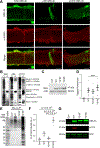GSK-3β Localizes to the Cardiac Z-Disc to Maintain Length Dependent Activation
- PMID: 35168370
- PMCID: PMC8930626
- DOI: 10.1161/CIRCRESAHA.121.319491
GSK-3β Localizes to the Cardiac Z-Disc to Maintain Length Dependent Activation
Abstract
Background: Altered kinase localization is gaining appreciation as a mechanism of cardiovascular disease. Previous work suggests GSK-3β (glycogen synthase kinase 3β) localizes to and regulates contractile function of the myofilament. We aimed to discover GSK-3β's in vivo role in regulating myofilament function, the mechanisms involved, and the translational relevance.
Methods: Inducible cardiomyocyte-specific GSK-3β knockout mice and left ventricular myocardium from nonfailing and failing human hearts were studied.
Results: Skinned cardiomyocytes from knockout mice failed to exhibit calcium sensitization with stretch indicating a loss of length-dependent activation (LDA), the mechanism underlying the Frank-Starling Law. Titin acts as a length sensor for LDA, and knockout mice had decreased titin stiffness compared with control mice, explaining the lack of LDA. Knockout mice exhibited no changes in titin isoforms, titin phosphorylation, or other thin filament phosphorylation sites known to affect passive tension or LDA. Mass spectrometry identified several z-disc proteins as myofilament phospho-substrates of GSK-3β. Agreeing with the localization of its targets, GSK-3β that is phosphorylated at Y216 binds to the z-disc. We showed pY216 was necessary and sufficient for z-disc binding using adenoviruses for wild-type, Y216F, and Y216E GSK-3β in neonatal rat ventricular cardiomyocytes. One of GSK-3β's z-disc targets, abLIM-1 (actin-binding LIM protein 1), binds to the z-disc domains of titin that are important for maintaining passive tension. Genetic knockdown of abLIM-1 via siRNA in human engineered heart tissues resulted in enhancement of LDA, indicating abLIM-1 may act as a negative regulator that is modulated by GSK-3β. Last, GSK-3β myofilament localization was reduced in left ventricular myocardium from failing human hearts, which correlated with depressed LDA.
Conclusions: We identified a novel mechanism by which GSK-3β localizes to the myofilament to modulate LDA. Importantly, z-disc GSK-3β levels were reduced in patients with heart failure, indicating z-disc localized GSK-3β is a possible therapeutic target to restore the Frank-Starling mechanism in patients with heart failure.
Keywords: calcium; cardiac myocytes; connectin; mice; myofibrils.
Figures






Similar articles
-
Differential changes in titin domain phosphorylation increase myofilament stiffness in failing human hearts.Cardiovasc Res. 2013 Sep 1;99(4):648-56. doi: 10.1093/cvr/cvt144. Epub 2013 Jun 13. Cardiovasc Res. 2013. PMID: 23764881
-
Titin strain contributes to the Frank-Starling law of the heart by structural rearrangements of both thin- and thick-filament proteins.Proc Natl Acad Sci U S A. 2016 Feb 23;113(8):2306-11. doi: 10.1073/pnas.1516732113. Epub 2016 Feb 8. Proc Natl Acad Sci U S A. 2016. PMID: 26858417 Free PMC article.
-
Protein S-Nitrosylation Controls Glycogen Synthase Kinase 3β Function Independent of Its Phosphorylation State.Circ Res. 2018 May 25;122(11):1517-1531. doi: 10.1161/CIRCRESAHA.118.312789. Epub 2018 Mar 21. Circ Res. 2018. PMID: 29563102 Free PMC article.
-
Discovery of Titin and Its Role in Heart Function and Disease.Circ Res. 2025 Jan 3;136(1):135-157. doi: 10.1161/CIRCRESAHA.124.323051. Epub 2025 Jan 2. Circ Res. 2025. PMID: 39745989 Review.
-
Glycogen synthase kinase-3β: A multifaceted player in ischemia-reperfusion injury and its therapeutic prospects.J Cell Physiol. 2024 Sep;239(9):e31335. doi: 10.1002/jcp.31335. Epub 2024 Jul 4. J Cell Physiol. 2024. PMID: 38962880 Review.
Cited by
-
Pterostilbene attenuates heart failure by inhibiting myocardial ferroptosis through SIRT1/GSK-3β/GPX4 signaling pathway.Heliyon. 2024 Jan 20;10(3):e24562. doi: 10.1016/j.heliyon.2024.e24562. eCollection 2024 Feb 15. Heliyon. 2024. PMID: 38318046 Free PMC article.
-
Small Angle X-ray Diffraction as a Tool for Structural Characterization of Muscle Disease.Int J Mol Sci. 2022 Mar 11;23(6):3052. doi: 10.3390/ijms23063052. Int J Mol Sci. 2022. PMID: 35328477 Free PMC article. Review.
-
GSK-3 at the heart of cardiometabolic diseases: Isoform-specific targeting is critical to therapeutic benefit.Biochim Biophys Acta Mol Basis Dis. 2023 Aug;1869(6):166724. doi: 10.1016/j.bbadis.2023.166724. Epub 2023 Apr 23. Biochim Biophys Acta Mol Basis Dis. 2023. PMID: 37094727 Free PMC article. Review.
-
Myofilament-associated proteins with intrinsic disorder (MAPIDs) and their resolution by computational modeling.Q Rev Biophys. 2023 Jan 11;56:e2. doi: 10.1017/S003358352300001X. Q Rev Biophys. 2023. PMID: 36628457 Free PMC article. Review.
-
Mitochondrial Kinase Signaling for Cardioprotection.Int J Mol Sci. 2024 Apr 19;25(8):4491. doi: 10.3390/ijms25084491. Int J Mol Sci. 2024. PMID: 38674076 Free PMC article. Review.
References
-
- Sakaguchi T, Takefuji M, Wettschureck N, Hamaguchi T, Amano M, Kato K, Tsuda T, Eguchi S, Ishihama S, Mori Y, Yura Y, Yoshida T, Unno K, Okumura T, Ishii H, Shimizu Y, Bando YK, Ohashi K, Ouchi N, Enomoto A, Offermanns S, Kaibuchi K and Murohara T. Protein Kinase N Promotes Stress-Induced Cardiac Dysfunction Through Phosphorylation of Myocardin-Related Transcription Factor A and Disruption of Its Interaction With Actin. Circulation. 2019;140:1737–1752. - PubMed
-
- Ai X, Curran JW, Shannon TR, Bers DM and Pogwizd SM. Ca2+/calmodulin-dependent protein kinase modulates cardiac ryanodine receptor phosphorylation and sarcoplasmic reticulum Ca2+ leak in heart failure. Circ Res. 2005;97:1314–22. - PubMed
-
- Fuller SJ, Osborne SA, Leonard SJ, Hardyman MA, Vaniotis G, Allen BG, Sugden PH and Clerk A. Cardiac protein kinases: the cardiomyocyte kinome and differential kinase expression in human failing hearts. Cardiovasc Res. 2015;108:87–98. - PubMed
-
- Lee DI, Zhu G, Sasaki T, Cho GS, Hamdani N, Holewinski R, Jo SH, Danner T, Zhang M, Rainer PP, Bedja D, Kirk JA, Ranek MJ, Dostmann WR, Kwon C, Margulies KB, Van Eyk JE, Paulus WJ, Takimoto E and Kass DA. Phosphodiesterase 9A controls nitric-oxide-independent cGMP and hypertrophic heart disease. Nature. 2015;519:472–6. - PMC - PubMed
-
- Komamura K, Shannon RP, Ihara T, Shen YT, Mirsky I, Bishop SP and Vatner SF. Exhaustion of Frank-Starling mechanism in conscious dogs with heart failure. American Journal of Physiology-Heart and Circulatory Physiology. 1993;265:H1119–H1131. - PubMed
Publication types
MeSH terms
Substances
Grants and funding
LinkOut - more resources
Full Text Sources
Medical
Molecular Biology Databases
Research Materials
Miscellaneous

